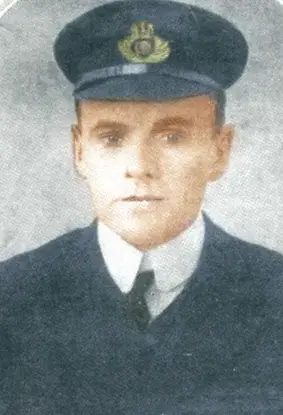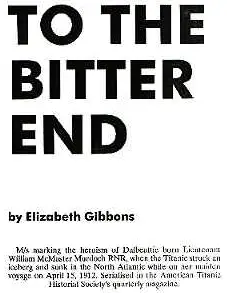The complete monograph by Elizabeth Gibbons:
Side Menu:
15. Change of the Watch
At 9:45 pm, standby Quartermaster Alfred Olliver knocked on Murdoch's cabin door and reported the time. At 10:00 pm, William Murdoch arrived on the bridge to assume the Watch. He had donned a greatcoat and was flapping his arms around himself, his first words to Lightoller jocular and obvious: "It's pretty cold". The temperature had fallen sharply and was now approximately 31 Fahrenheit. The United States Senate said that this indicated the nearness of ice; Lightoller said that it did not. For a few minutes, while Murdoch's eyes adjusted to darkness, the two men merely talked: it was their custom, Lightoller would write, to stand looking ahead and simply chat about "times and incidents past and present". They then went on to discuss the future:
Mr. Lightoller: When I ended the watch we roughly judged that we should be getting toward the vicinity of the ice, as reported by that Marconigram that I saw, somewhere about 11 o'clock.
. . . . .
Senator Smith: I say [said], did you talk with Mr. Murdock about the iceberg situation when you left the watch?
Mr. Lightoller: No, sir.
Senator Smith: Did he ask you anything about it?
Mr. Lightoller: No, sir.
Senator Smith: What was said between you?
Mr. Lightoller: We remarked on the weather, about its being calm, clear. We remarked the distance we could see. We seemed to be able to see a long distance. Everything was very clear. We would see the stars setting down to the horizon. (Page 68)
Later, Lightoller would augment this testimony:
Senator Smith: What was the conversation between you?
Mr. Lightoller: I remarked on the general condition of the weather, and so on, etc., and then I just mentioned, as I had done previously, 'We will be up around the ice somewhere about 11 o'clock, I suppose'. That is all." (Page 439)
Just prior to this statement, Lightoller reiterated that he had mentioned the probable 11:00 pm rendezvous with the ice field when Murdoch returned from lunch, and "I spoke about it in the quarters, unofficially, and I also spoke about it, naturally, when he relieved me at 10 o'clock." (Page 438)
Just why Lightoller insisted they had not discussed icebergs as opposed to ice generally is a mystery, unless he was endeavoring to imply that they were, in fact, expecting merely the "small ice and growlers" he admitted instructing Sixth Officer Moody to warn the lookouts they might encounter. At 7:15 pm, Murdoch had himself instructed Trimmer Samuel Hemming to be certain that the forward forecastle hatch was closed, as he wanted the area before the bridge absolutely dark; if this was not a routine warning, and Hemming did not say that it was, then Murdoch by sundown was preparing for the grim task of searching for the ice they knew would appear ahead during the early hours of his watch. No one can say he had not been warned.

Second Officer Charles Lightoller
Lightoller officially gave the Titanic into Murdoch's care, and left the bridge to make his last round of the ship before retiring. They would never speak again.
Upon returning to the officer's quarters, Lightoller apparently made one last survey of the bridge; in the quiet blackness he saw Murdoch on one wing of the bridge, watching ahead, and noticed Captain Smith standing on the opposite wing. He would state that this was after the collision (page 68) but his memory was clearly in error; afterwards, Smith and Murdoch went onto the starboard wing, looking aft for the iceberg. As the Captain's quarters were on the starboard side, a few feet to the starboard wing for a last look ahead would be more convenient than crossing the bridge. The sequence mentioned, therefore, (Murdoch, then the Captain) would imply their positions: the Fates had arranged that Murdoch would choose that night to stand watch on the port side the side away from the iceberg.
Lightoller went to bed. Captain Smith went back to his quarters, but remained fully dressed; it may have been now that he opened the cabin window that still remains open. On the bridge, as it neared 11:40 pm, Quartermaster Robert Hichens was at the wheel inside the glass enclosed wheelhouse. Sixth Officer James Moody was on the bridge beside the telephone connection to the crow's nest. Standby Quartermaster Alfred Olliver was in the wheelhouse, trimming the oil light for the steering compass. Fourth Officer Joseph Boxhall was approaching the bridge along the starboard boatdeck, almost abreast of the captain's quarters. It was completely quiet.
In the crow's nest were Frederick Fleet and his mate, Lee. At 10:00 pm they had replaced two other lookouts, Jewell and George Symons. Symons, like Fleet, had come from the Oceanic with Lightoller, who considered him the best lookout in the service of the White Star Line. At 11:40 pm on April 14th, the best lookout on the company payroll was in his bunk, asleep. In his stead was one man, Fleet, who had extraordinary difficulty in describing what he saw, and another one, Lee, whose testimony was thrown out at the British Inquiry by Lord Mersey as unreliable. In the crow's nest, too, it was totally silent.
